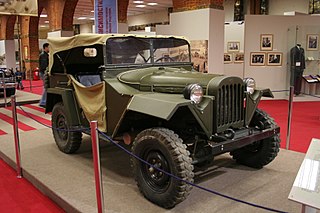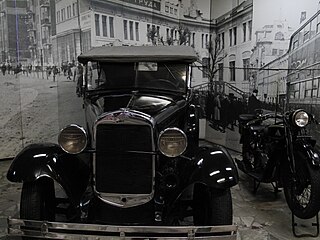 W
WThe GAZ Chaika, which means gull, is a luxury automobile from the Soviet Union made by GAZ. The vehicle is one step down from the ZIL-111 limousine. Chaika production consisted of two generations, the GAZ-13 of 1959 to 1981 and the GAZ-14 of 1977 to 1988.
 W
WThe ZIM-12 was a Soviet limousine produced by the Gorky Automotive Plant from 1950 until 1960. It was the first executive car produced by GAZ and the first one to have the famous leaping deer hood ornament. The car was built to serve high and medium rank Soviet nomenklatura, but was also readily available as a taxi and ambulance. Unlike its successors, ZIM was the only Soviet executive class full-size car that was actually made available for private ownership. A total of 21,527 examples were built.
 W
WThe GAZ-13 Chaika (Seagull) is an automobile manufactured by the Gorkovsky Avtomobilny Zavod from 1959 to 1981 as a generation of its Chaika marque.
 W
WThe GAZ-14 Chaika is an automobile manufactured by the Gorkovsky Avtomobilny Zavod from 1977 to 1988 as a generation of its Chaika marque.
 W
WThe GAZ-61 was a four wheel drive car from USSR manufacturer GAZ first introduced in 1938 by designer V. A. Gratchev, to replace his too-complex model GAZ-M2.
 W
WThe GAZ-64 was a 4x4 vehicle made by GAZ, succeeding the earlier GAZ-61. Its design was led by Vitaliy Grachev. The design process was exceptionally quick, taking only a few weeks.
 W
WThe GAZ-67 and the subsequent GAZ-67B were general-purpose four-wheel drive Soviet military vehicles built by GAZ starting in 1943. By the end of the war, it was the Soviet equivalent of the Willys Jeep.
 W
WThe GAZ-2332 / GAZ CityVan was a light van developed by the Russian automaker GAZ and presented as a prototype at an apparently advanced stage of development in 2006. The van was shown with seating for two and a load area capable of carrying between 500 and 1,000 kg. It was powered by a 2492cc Chrysler petrol/gasoline engine producing a claimed maximum output of 137 PS, using the same block as that fitted in the more powerful versions of the Volga Siber passenger car.
 W
WThe GAZ-5903V Vetluga is a Russian heavy firefighting vehicle, a modified BTR-70 amphibious armored personnel carrier with an externally mounted fire suppression system in a large vertically movable turret. The turret mounts 11 large tubes filled with powdered firefighting chemicals. It is derived from the GAZ-59037. Its purpose is to be able to put out large, high-risk industrial fires, and resolve a variety of other situations involving grave risk of explosion. The crew has a communications system, and filtered ventilation. Extra tools and equipment are also carried.
 W
WThe GAZ-A was a passenger car that was mass-produced by GAZ from 1932 to 1936. It was the first passenger car to be produced in the Soviet Union and is a near-exact copy of the Ford Model A from 1930. To the local population, the car was nicknamed "Gazik".
 W
WThe GAZ M1 (“Эмка“/”Emka”) was a passenger car produced by the Soviet automaker GAZ between 1936 and 1943, at their plant in Gorky.
 W
WThe GAZ-M20 "Pobeda" was a passenger car produced in the Soviet Union by GAZ from 1946 until 1958. It was also licensed to Polish Passenger Automobile Factory, as FSO Warszawa. Although usually known as the GAZ-M20, an original car's designation at that time was just M-20, for "Molotovets".
 W
WThe GAZelle is a series of light commercial vehicles: pickup trucks, vans and minibuses made by Russian car manufacturer GAZ. At the time of the dissolution of the Soviet Union and transition to a market economy, the Russian automobile industry had not produced a much-demanded LCV similar to the Ford Transit or VW T4 class. The GAZelle shares many parts with the company's passenger cars, in fact, models produced until 1998 had the same grille. Riga Autobus Factory, which formerly manufactured minibuses for the whole USSR, remained in Latvia, now required its vehicles be sold to the now-foreign Russian market for hard currency. Responding to this market opportunity, GAZ swiftly developed its own LCV called GAZelle, that taken together with its lighter version Sobol now account for the majority of the Russian van and light truck market and has strong positions in the markets of other CIS countries, ranking as GAZ's most popular and successful products.
 W
WThe GAZelle NEXT is a product improved version of the original GAZelle series of medium duty vans and trucks produced by the Russian automotive giant GAZ. It is produced alongside the original GAZelle now known as the GAZelle Business.
 W
WThe GAZ Sobol is a series of Russian light-duty trucks, vans and minivans, produced by the Gorky Automobile Plant from November 1998. GAZ refers to the Sobol as a minivan.